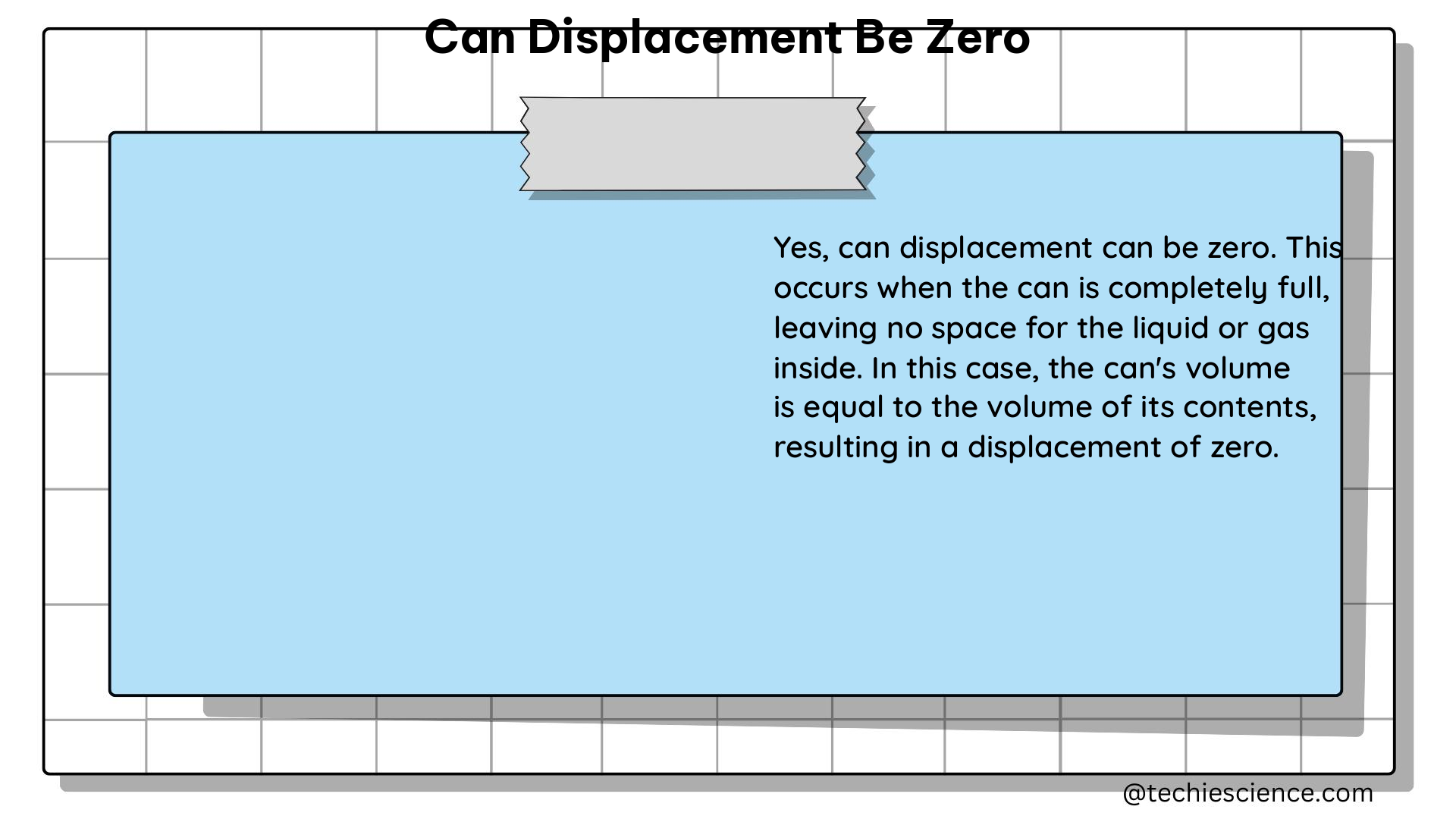Displacement, a fundamental concept in physics, is the change in position of an object relative to its initial position. While it may seem counterintuitive, displacement can indeed be zero, even when there is movement involved. This concept is crucial in understanding various physical phenomena, particularly in the fields of kinematics and biomechanics.
Theoretical Explanation and Formulas
Displacement is a vector quantity, meaning it has both magnitude and direction. It is calculated by subtracting the initial position from the final position of the object:
Δd = d_final – d_initial
Where Δd represents the displacement, d_final is the final position, and d_initial is the initial position.
Displacement can be positive, negative, or zero. A displacement of zero indicates that the object has returned to its initial position, despite any movement or distance traveled.
In angular kinematics, the displacement of a point on a rotating body can be calculated using the formula:
d = rθ
Where d is the linear displacement, r is the radius, and θ is the angular displacement expressed in radians.
For uniform circular motion, the angular displacement is defined as the ratio of the arc length to the radius of curvature:
Δθ = Δs / r
Where Δs is the arc length and r is the radius of curvature.
Examples and Measurable Quantities

-
Straight-line motion: Consider a car driving along a straight road from point A to point B and then back to point A. The distance traveled by the car is the total path length, which is the sum of the distances from A to B and from B to A. However, the displacement is the difference between the final and initial positions, which is zero in this case because the car has returned to its initial position.
-
Circular motion: Another example is the motion of an object in a circular path, such as the Earth orbiting the Sun. After completing one full orbit, the displacement of the Earth is zero because it has returned to its initial position, but the distance traveled is not zero because the Earth has covered a significant distance along its orbit.
-
Biomechanics: In the context of biomechanics, consider the movement of the arm during a jumping jack. The angular displacement of the arm is 180 degrees, but the linear displacement of each point on the arm varies depending on its distance from the axis of rotation (shoulder joint). The linear displacement of a point closer to the shoulder joint is smaller than that of a point further away from the shoulder joint.
In physics, the units used for displacement are typically meters (m) or other units of length. Angular displacement is measured in radians (rad), where 1 radian is approximately 57.3 degrees.
Technical Specifications and Advanced Details
When calculating displacement, it is essential to consider the frame of reference, which is the point or coordinate system from which the position of the object is measured. The displacement of an object depends on the choice of the frame of reference.
For example, if an object is moving in a circular path, its displacement may be zero when measured from the center of the circle, but non-zero when measured from a different reference point.
Additionally, the concept of displacement can be further explored in the context of relative motion. When an object is moving relative to another object, the displacement of the first object can be different from the displacement of the second object, depending on their respective frames of reference.
Numerical Problems and Calculations
- Circular motion: A point on the rim of a rotating wheel has a radius of 0.5 m. If the wheel rotates through an angle of 90 degrees, calculate the linear displacement of the point.
Given:
– Radius (r) = 0.5 m
– Angular displacement (θ) = 90 degrees = π/2 radians
Using the formula: d = rθ
Displacement (d) = r × θ
Displacement (d) = 0.5 m × (π/2 rad) = 0.785 m
- Straight-line motion: A car travels 50 km from point A to point B and then returns to point A. What is the total distance traveled and the displacement of the car?
Total distance traveled = 50 km + 50 km = 100 km
Displacement = d_final – d_initial = 0 km (since the car returned to its initial position)
Conclusion
In summary, displacement can be zero even when there is movement involved. This concept is crucial in understanding various physical phenomena, such as circular motion and biomechanics. By understanding the formulas, examples, and technical specifications associated with displacement, students can deepen their understanding of this fundamental concept in physics.
References:
- Measurable Quantity – an overview | ScienceDirect Topics, https://www.sciencedirect.com/topics/engineering/measurable-quantity
- 5.1 Angular Position and Displacement – Biomechanics of Human Movement, https://pressbooks.bccampus.ca/humanbiomechanics/chapter/6-1-rotation-angle-and-angular-velocity-2/
- Can displacement be 0? If yes give an example – BYJU’S, https://byjus.com/question-answer/can-displacement-be-0-if-yes-give-an-example/
- Physics: Chapter 2 Flashcards, https://quizlet.com/725152620/physics-chapter-2-flash-cards/
- Can displacement be zero even if distance is not zero ? Give one example to explain your answer., https://byjus.com/question-answer/can-displacement-be-zero-even-if-distance-is-not-zero-give-one-example-to-explain/
Hi, I’m Akshita Mapari. I have done M.Sc. in Physics. I have worked on projects like Numerical modeling of winds and waves during cyclone, Physics of toys and mechanized thrill machines in amusement park based on Classical Mechanics. I have pursued a course on Arduino and have accomplished some mini projects on Arduino UNO. I always like to explore new zones in the field of science. I personally believe that learning is more enthusiastic when learnt with creativity. Apart from this, I like to read, travel, strumming on guitar, identifying rocks and strata, photography and playing chess.